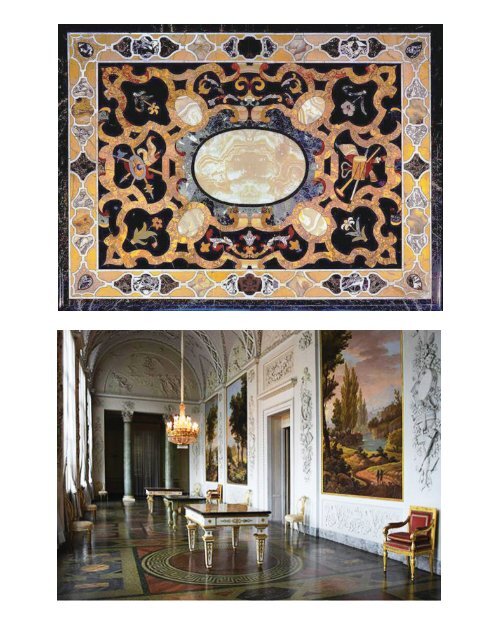Italian Inlaid Marble Tabletop
Create successful ePaper yourself
Turn your PDF publications into a flip-book with our unique Google optimized e-Paper software.
Soon enough, Florence developed its own variation of this decorative<br />
craft, employing figural decoration – plants, trophies, etc. –<br />
supplementing the more rigorously geometric design characteristic of<br />
Roman work.<br />
The design of the table described here adheres to that earlier, Roman<br />
approach. And yet, as we shall see, it is closely related to another,<br />
almost certainly later, inlaid marble top which also exhibits Florentine<br />
characteristics.<br />
Our table is 58.625” x 44.5”. It includes a marble edge similar to<br />
portoro, but which may be giallo e nero antico, a not quite identical<br />
stone whose quarrying began earlier. Inside this is a band of repeating<br />
geometric ornament in a variety of stones including carrara, bianco<br />
e nero antico, at least three different types of brecciated marbles –<br />
traccagnini, corallina, and possibly diaspro tenero di Sicilia - as well as<br />
alabasters, including pecorella.<br />
This repeating ornament frames a large rectangle, featuring curvilinear<br />
“strapwork” in giallo antico with accents in rosso antico, alabastro fiorito,<br />
and a white stone with diffuse red veining which is, so far, unidentified.<br />
The strapwork outlines sections of africano marble, and four ovals in<br />
alabastro fiorito, and surrounds a field of verde antico, which further<br />
frames a thin oval band of nero antico. Inside this is the table’s<br />
center-piece, a semi-transparent/translucent oval of antique Egyptian<br />
alabaster, perhaps alabastro cotognini.<br />
The underside of the table is a single stone slab of peperino, running to<br />
the edge of the molded band of giallo e nero antico. This slab, though<br />
antique, may postdate the marble inlay work.<br />
The effect, of course is very, very grand.<br />
Provocatively, our table is remarkably similar to one now in Florence’s<br />
Villa del Poggio Imperiale, and before that, in the city’s Palazzo Pitti,<br />
both places with intimate connections to Ferdinando de Medici.<br />
Opposite above - Similar tabltetop currently in the Villa del Poggio Imperiale,<br />
Florence.<br />
Opposite below - Similar tabletop, on a later base, in Il Perestilio, Villa del<br />
Poggio Imperiale


